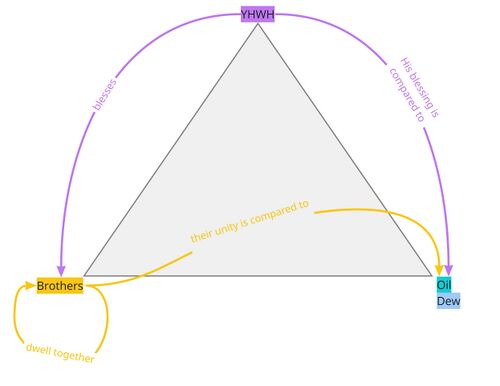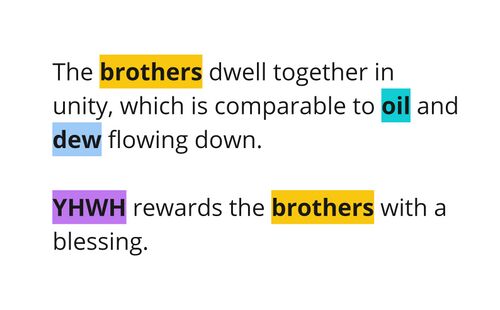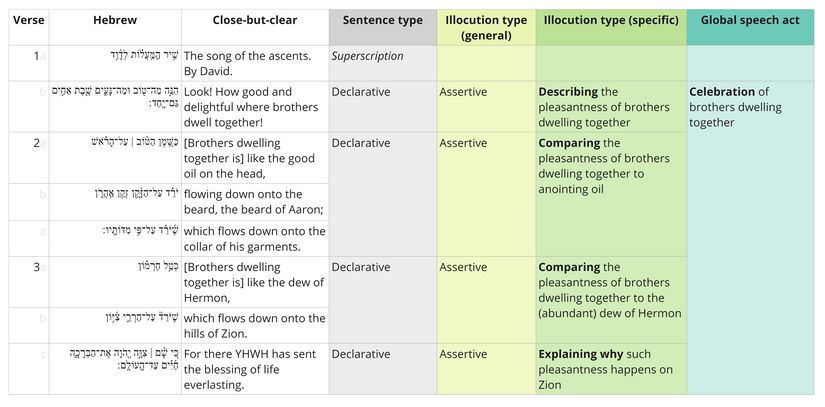Psalm 133 Discourse
About the Discourse Layer
Our Discourse layer includes four analyses: macrosyntax, speech act analysis, emotional analysis, and participant analysis. (For more information, click 'Expand' to the right.)
Macrosyntax
The macrosyntax layer rests on the belief that human communicators desire their addressees to receive a coherent picture of their message and will cooperatively provide clues to lead the addressee into a correct understanding. So, in the case of macrosyntax of the Psalms, the psalmist has explicitly left syntactic clues for the reader regarding the discourse structure of the entire psalm. Here we aim to account for the function of these elements, including the identification of conjunctions which either coordinate or subordinate entire clauses (as the analysis of coordinated individual phrases is carried out at the phrase-level semantics layer), vocatives, other discourse markers, direct speech, and clausal word order.
For a detailed explanation of our method, see the Macrosyntax Creator Guidelines.
Speech Act Analysis
The Speech Act layer presents the text in terms of what it does, following the findings of Speech Act Theory. It builds on the recognition that there is more to communication than the exchange of propositions. Speech act analysis is particularly important when communicating cross-culturally, and lack of understanding can lead to serious misunderstandings, since the ways languages and cultures perform speech acts varies widely.
For a detailed explanation of our method, see the Speech Act Analysis Creator Guidelines.
Emotional Analysis
This layer explores the emotional dimension of the biblical text and seeks to uncover the clues within the text itself that are part of the communicative intent of its author. The goal of this analysis is to chart the basic emotional tone and/or progression of the psalm.
For a detailed explanation of our method, see the Emotional Analysis Creator Guidelines.
Participant Analysis
Participant Analysis focuses on the characters in the psalm and asks, “Who are the main participants (or characters) in this psalm, and what are they saying or doing? It is often helpful for understanding literary structure, speaker identification, etc.
For a detailed explanation of our method, see the Participant Analysis Creator Guidelines.
Discourse Visuals for Psalm 133
Macrosyntax
Notes
Word Order
- The fronting of שָׁם within its clause signals its function as selective focus, as illustrated by the cleft-structure in English: "it is there that..." (cf. CEB, CJB, DHH, NBS, NET, NFC, PDV, SG21). As selective focus, it necessarily eliminates other possible locations of where YHWH may have sent the blessing.
Discourse Markers
- הִנֵּה is used prototypically in v. 1, serving to focus attention on the utterance that follows it (BHRG §44.3.3.3.c).
Conjunctions
- It's not quite clear why the first instance in the psalm of the participle יֹרֵד in 2b does not have the relative conjunction שֶׁ that you see in the following instances of יֹרֵד, in 2c and 3b. One possibility could be phonology: the יֹרֵד that does not have the שֶׁ immediately follows a שֶׁ sound, so the שֶׁ on יֹרֵד might have been dropped.
- V. 1b could serve as the thesis statement for the whole psalm, especially when paired with the focus at the end of the verse: יָחַד "together", marked with another emphatic particle, גַּם 'gam'. גַּם serves to emphasize the idea of "together". It could be a simple situation of intensifying the idea (very together = in great unity), or it could be what BHRG calls an "extreme case"--a situation that one would not expect (in this context, one would not expect people to live in such great unity) (§41.4.5.2.1.c)
- The for (כִּי) that begins this clause, though treated differently among modern translations, is most likely understood as having a causal meaning ("for" or "because"). It provides the reason, or grounds, for the claim that brothers dwelling together is good and pleasant. See a full discussion of this exegetical issue in The Function and Scope of כִּי in Ps. 133:3.
Speech Act Analysis
Summary Visual
Speech Act Chart
Notes
- The psalm's global speech act is a celebration of brothers dwelling together.
- The intended perlocutionary effect of the celebration is to urge the hearers to strive for brotherly unity.
Emotional Analysis
Summary visual
Emotional Analysis Chart
Participant analysis
There are 5 participants/characters in Psalm 133:

- Brothers: These are not necessarily biological brothers, but rather a way to denote the extended family/the entire congregation of Israel. In the context of this psalm, these are the pilgrims who have been traveling to Jerusalem for a holy festival.
- Oil and Dew: Though not exactly participants per se, these two liquids play a prominent role in this psalm. They are used for comparison to the pleasantness of the congregation's unity, and they display the heart of the psalm's message.
- Aaron: The first high priest of the people of Israel. Here, he is not an active participant, but rather is used as a symbol for the priesthood.
Participant Relations Diagram
The relationships among the participants may be abstracted and summarized as follows:


Participant Analysis Table
Notes
- v. 2c: oil or beard?
- The grammar is ambiguous as to whether it is the oil that is flowing down onto Aaron's garments, or if it's the beard. See our treatment of this issue here: The Antecedent of שֶׁיֹּרֵד in Ps. 133:2.





